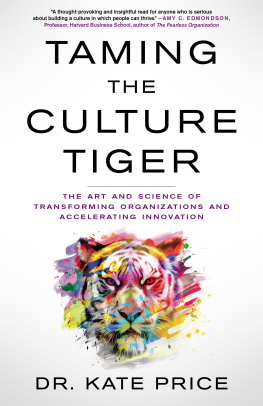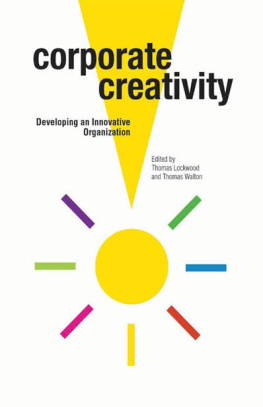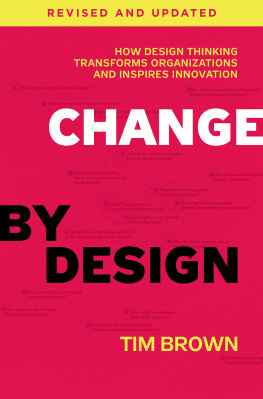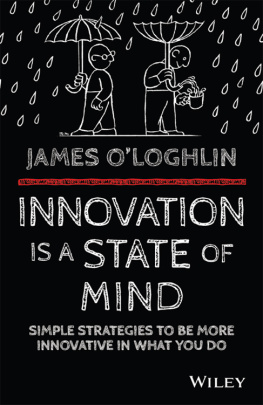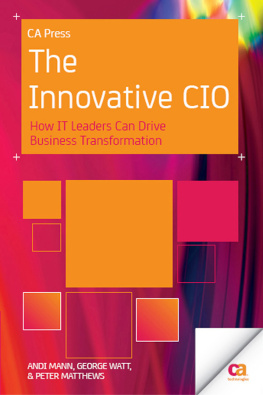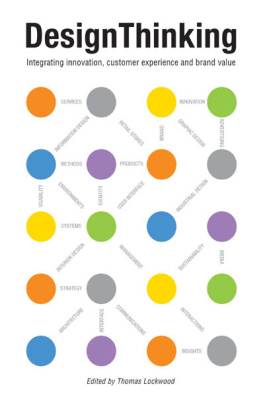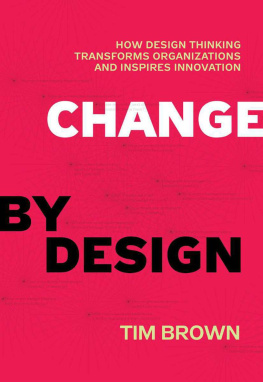INNOVATION BY DESIGN
How Any Organization Can Leverage Design Thinking to Produce Change, Drive New Ideas, and Deliver Meaningful Solutions
THOMAS LOCKWOOD AND EDGAR PAPKE

Copyright 2018 by Thomas Lockwood and Edgar Papke
All rights reserved under the Pan-American and International Copyright Conventions. This book may not be reproduced, in whole or in part, in any form or by any means electronic or mechanical, including photocopying, recording, or by any information storage and retrieval system now known or hereafter invented, without written permission from the publisher, The Career Press.
INNOVATION BY DESIGN
Edited by Jodie Brandon
Typeset by PerfecType
Printed in the U.S.A.
To order this title, please call toll-free 1-800-CAREER-1 (NJ and Canada: 201-848-0310) to order using VISA or MasterCard, or for further information on books from Career Press.

The Career Press, Inc. 12 Parish Drive
Wayne, NJ 07470
www.careerpress.com
Library of Congress Cataloging-in-Publication Data
CIP Data Available Upon Request.
Our work is dedicated to the Creative Class. By the way, thats everyone.
CONTENTS
The Context

Better Innovation
Imagination is more important than knowledge. For knowledge is limited to all we now know and understand, while imagination embraces the entire world, and all there ever will be to know and understand.
Albert Einstein
The collective imagination is humankinds greatest genius. Throughout our human history, as we developed and created the world around us, the sharing and building of one idea on another has been, and always will be, our best recipe for innovation. The world we continuously create for ourselves is the manifestation of our collective imagination, the natural desire to come together in community; to collaborate, explore, and learn; and to create what we want and desire to have. It gives us the ability to respond to our basic needs, as well as solve even the most complex of problems. It fuels the innovation that is the foundation of our competitive global business society. It is our collective imagination that provides us with the source of the innovation through which we create a better world and through which we find ways to guide and change the human experience. Humankinds desire and drive for innovation is breathtaking. Innovation is who we are. It is what we do best.
As our societies evolved, we creatively designed social structures that met the needs of and further relied on our shared ability to innovate. As we did, we were reminded that along with our innate desire to innovate, we have an inborn desire to compete. When these forces come together, innovation is accelerated. The social structures that we relied on for survival and connectivity evolved into enterprises of commercial means that have become the fixtures of our global society. These new enterprises and organizations became the vehicles that took us on the journeys of the scientific, industrial, and more recently information revolutions. All along the way, we continuously increased our level of innovation and ramped up the pace of change in our world.
Today we find ourselves at a place in history in which our capability for innovating and creating change has provided us with incredible levels of technology and know-how. Every day we find ourselves exposed to new ideas. Moment by moment we are introduced to an array of new products and services, some of which are delivered to us by purpose-driven, design thinking organizations and enterprises whose main concern is to figure out how to create more meaningful innovation and customer experiences. We are now operating in a new global era in which a new digital economy is emerginga new economy driven by pioneering technology that allows for virtually everyone and everything in our world to be connected, with new pathways for information and knowledge abounding: the Internet of Things, the interconnection via the Internet of computing and smart deviceselectronics, software, sensors, actuators, and network connectivitythat enable objects to collect and exchange data. All this adds to a world that presents us with the means to faster and faster, innovate more and moreall evidence of how we leverage our collective imagination to creatively solve problems and meet the needs of humankind. Innovation is what we do best.
STRUGGLING WITH INNOVATION
With all the knowledge and technology available to us, and the means of immediate communication and instant access to information at our fingertips, why does our focus constantly return to how we can become even more innovative, to solve bigger and more complex problems? Why does so much of our attention remain centered on finding ways to organize and work together better to further leverage our ability to innovate? Why is meaningful innovation the most important issue that organizations continue to grapple and struggle with?
Throughout the history of business, we have found ourselves trying to figure out how to maximize our human potential. Even today, and more than ever, companies and institutions of all types and sizes are concentrating on creating more innovative cultures. This is not a new breakthrough in thinking. Being successful has always relied on the ability to work together and be creative. More than science or the collection and use of data, the quest to understand how to create higher levels of innovation and empower our creative intelligence seems to be a more elusive aspect of how we innovate. The better we become at innovation and creative collaboration, the more we want to figure out to get better at italas, human nature.
Purpose-driven, design thinking organizations and enterprises create more meaningful innovation and customer experiences.
In pursuit of innovation, we have created complex organizations, with many moving parts, all adding to the complexity of our solutions, of our livesuntil we come to the place of recognizing what the great designer Dieter Rams pointed out many years ago: less, but better.
As complex as the world is today, we look for finding solutions to the resulting challenges and emotional stress that all the moving parts and advanced technology creates. The more complicated means of communication and interaction move us to a place from which we seek greater simplification. We have arrived at a place in our history that causes us to pause and reflect on the complexity of the organizational systems that humankind has created, looking for ways to overcome the needless barriers to communication and working together they represent. Why? So we can find better, faster, and, yes, simpler ways to work together to solve problems more efficiently and effectively. We want to innovate how our organizations can work more simply and allow for shared capacity to solve problems and innovate more freely.
To give you a sense of the magnitude of how important innovation is perceived to be to the success of todays organizations, one just has to look at the title of KPMGs 2016 Global CEO survey, aptly titled Now or Never. The executive summary delivers a clear message, sharing that [t]wo-thirds of chief executive officers (CEOs) believe that the next three years will be more critical than the last fifty years. The forces creating this inflection point are the rapidly evolving technology and the speed of transformation it unleashes. In four years time 4 out of 10 CEOs expect to be running significantly transformed companies.



